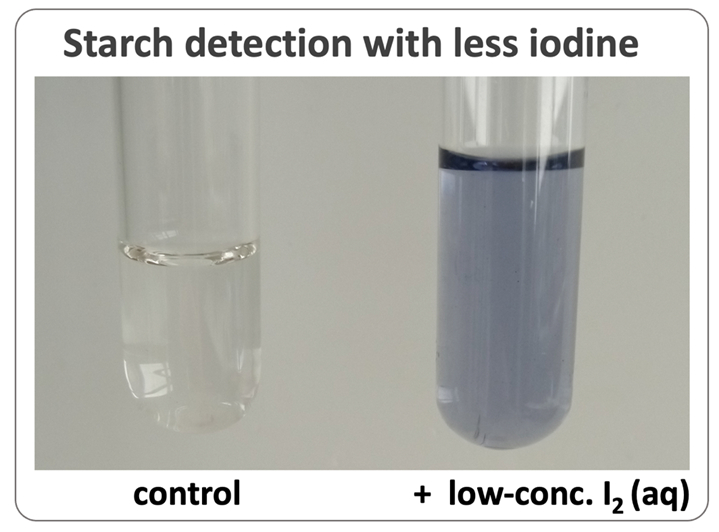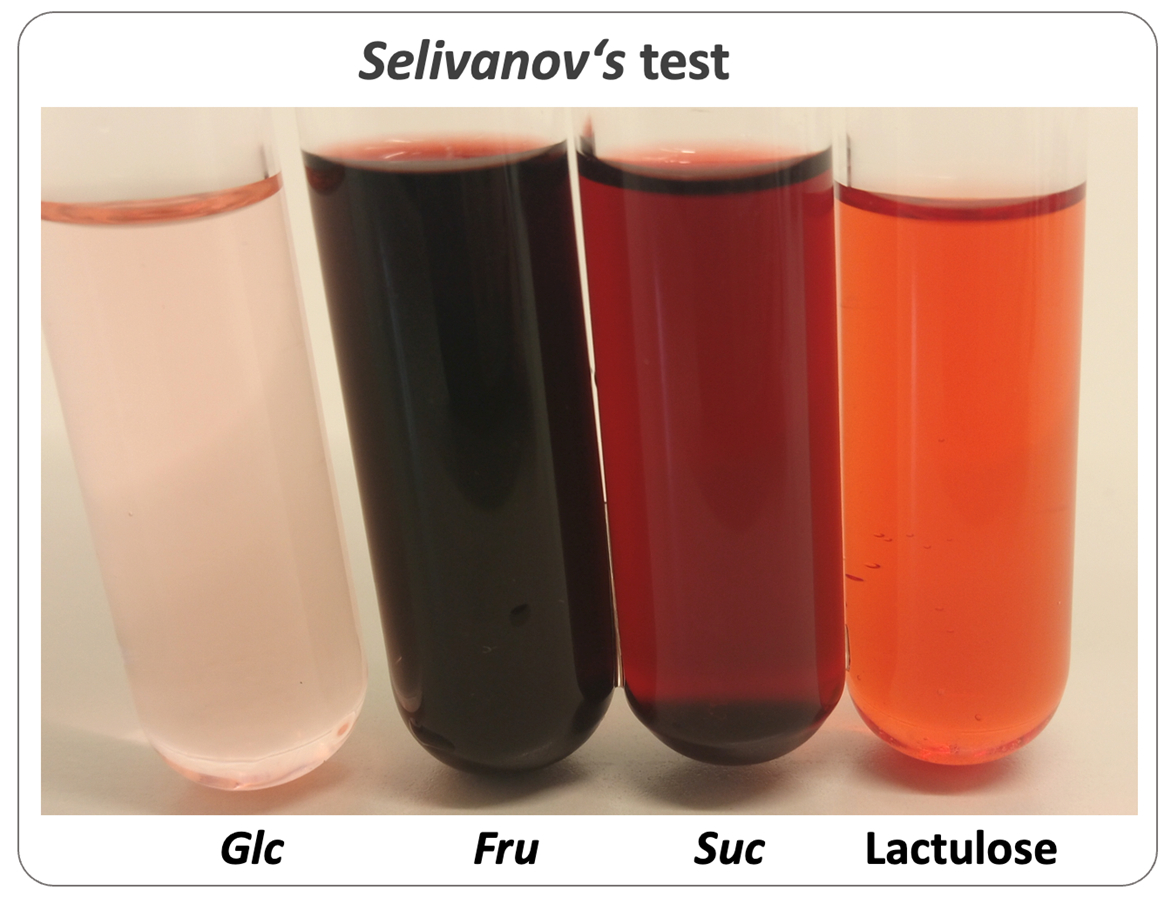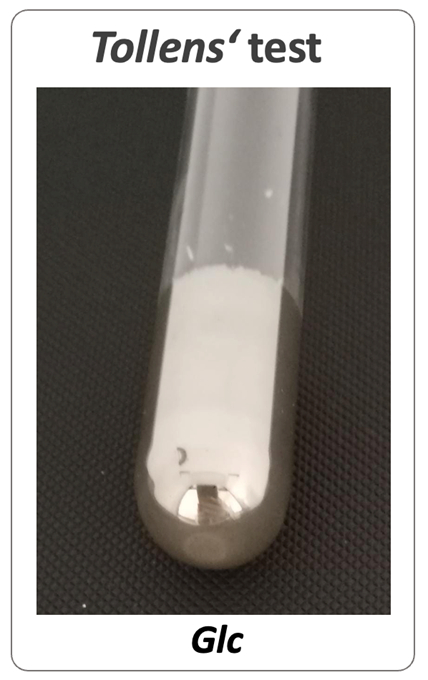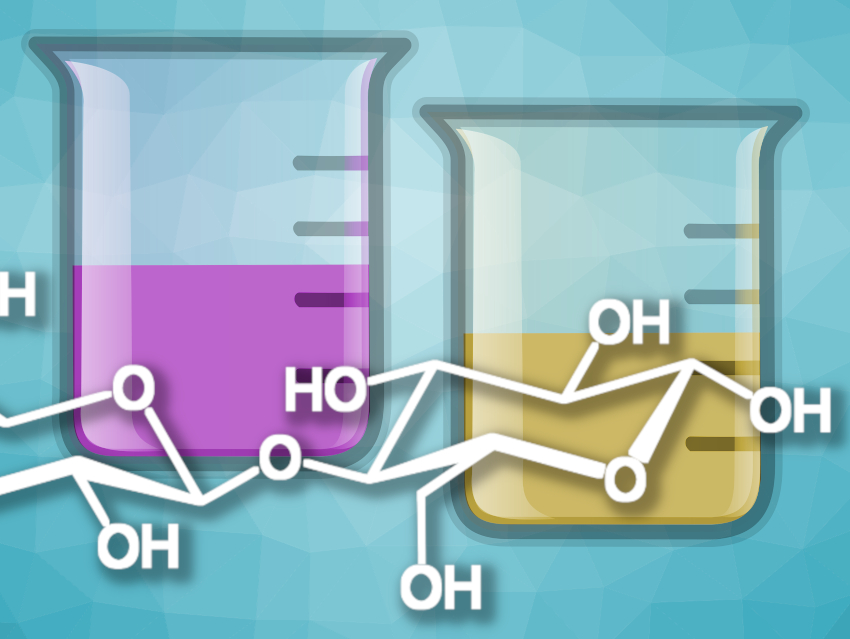This article examines the most frequently applied carbohydrate tests in secondary education chemistry labs and presents safer alternatives and procedures. In Part 1, we looked at historical carbohydrate detection reactions and a novel method for wet lab lactose detection. This part will deal with improved detection reactions for carbohydrates.
4. Starch Detection with Only a Fraction of Iodine
With the iodine assay, starch is detected by the formation of a colored iodine–starch inclusion compound in both solution or solid test substances (see Fig. 7). Here, the term iodine assay most commonly refers to the use of iodine tincture (ethanolic solution of iodine) or Lugol’s iodine.
Challenges: Over-the-counter iodine preparations used to be available in pharmacies and drug stores for wound disinfection. However, due to an increase in iodine hypersensitivity in the general population, iodine-based antiseptics have been widely replaced by alternatives such as phenoxyethanol and octenidine, thus limiting the availability of iodine solutions for starch detection experiments. Moreover, iodine and potassium iodide have been recently assigned the hazardous substance symbol GHS 08. This now applies to Lugol’s solution, too. Lugol’s solution is a collective term for aqueous solutions of iodine and potassium iodide with iodine concentrations of 1 %, 2 %, or even 5 % (w/w). From a safety perspective, their use in chemistry classes must now be viewed critically.
Recommendation: It has recently been shown by the authors [2] that starch detection is possible with less concentrated iodine solutions (0.025 mol/L; ω = 0.65 %), without a loss in sensitivity (see Fig. 7).
 |
|
Figure 7. Starch detection with low-concentration iodine solution (0.025 mol/L); left: starch solution 1 %; right: starch- plus iodine solutions. Photo: H. Rautenstrauch. |
For this, we add up to ten drops of the iodine solution (c = 0.025 mol/L) to the starch/food/analyte to be tested. A colorful iodine–starch inclusion compound is formed ranging from red, blue, or purple to black depending on (i) the starch source (e.g., potatoes, maize, wheat, rice), (ii) the type of preparation (e.g., natural, industrial), and (iii) the starch concentration in the test sample. In general, highly branched starch molecules cause a reddish stain (20–30 glucose units between branching points), while low-branching starch molecules (more than 45 glucose units) lead to a blue color impression [10]. In the case of black color impressions, the sample concentration should be reduced and solid starch should be dissolved by boiling. Contrary to earlier views, no tri- or pentaiodide ions are necessary for the formation of the colored iodine-starch inclusion compounds [11]. Due to the poor solubility of iodine in water, detection solutions should be prepared at least one day before first use.
5. Beyond Schultze & Seelinger: Cellulose Detection with a Novel Assay
Schultze’s reagent (also known as iodine-zinc-chloride solution) is most commonly used to detect cellulose; its presence is revealed by a blue to brown-violet stain or dye, depending on cellulose concentration or fibre structure. The mechanism underlying this change in color remains unclear, although it has been suggested that zinc and chloride ions promote swelling of the cellulose fiber structure and that interactions between iodine and cellulose molecules as well as zinc ions and cellulose are involved.
Challenges: Zinc chloride is considered hazardous (GHS 05, GHS 07, GHS 09). In the lesser-known Seeliger’s reagent (also: Selleger’s reagent), utilized to detect cellulose in combination with lignin, zinc chloride is substituted by calcium nitrate tetrahydrate. However, nitrate salts act as oxidizing agents and increase risk during a fire. Hence, we asked whether nitrate ions could be substituted by non-hazardous chloride ions [2].
Recommendations: Our recent work shows that cellulose can be detected with iodine–calcium chloride solution (see Fig. 8). For this, dissolve 0.03 g iodine and 14 g calcium chloride in 25 mL of demineralized water and store the solution in a brown glass bottle. Let the solution stand overnight so that the iodine dissolves completely. Add detection solution dropwise to test sample.
.jpg) |
|
Figure 8. Cellulose detection with novel iodine–calcium chloride solution; from left to right: cellulose, timecourse with cotton fabric. Photos: H. Rautenstrauch. |
6. A Safety Upgrade for Molisch’s Test
The Molisch test from 1886 has a unique “selling point” as it allows the differentiation of pentoses, hexoses, and deoxy sugars through differently colored reaction products: Pentoses form a green-bluish dye, deoxy sugars a dark orange, and hexoses a pink one (see Fig. 9). The mechanism underlying this dye formation remains to be clarified in detail.
Challenges: From a lab safety perspective, the use of 1-naphthol must be viewed critically as it is a hazardous substance with the labels “toxic, corrosive, harmful to the environment” and “activity prohibited for expectant and nursing mothers”. Therefore, it is reasonable to expect its ban from school labs in the near future. However, 1-naphthol should only be distributed to students as a diluted ready-to-use solution.
Recommendations: We recently demonstrated that hazardous 1-naphthol can be successfully substituted by the non-hazardous natural substance carvacrol [12] (see Fig. 9). The thymol used by Molisch in addition to 1-naphthol also leads to the formation of red dyes, but these do not allow for good color differentiation.
For this, add two drops of a sugar solution in water (e.g., arabinose ω = 5 %, rhamnose ω = 1 %, glucose ω = 5 %, Fig. 9) and mix with five drops of a carvacrol solution in ethanol (ω = 0.5 %) as well as ten drops of concentrated sulfuric acid. After ten minutes, add ten drops of demineralized water. Figure 9 shows the characteristic colorations for pentoses, deoxy sugars, and hexoses known for the classic Molisch assay—here performed with our modified protocol. We note that the dyes are unstable and will decay within one hour.
.jpg) |
|
Figure 9. Modified Molisch’s test with carvacrol; from left to right: arabinose (pentose), rhamnose (deoxy sugar), glucose (hexose). Photo: H. Rautenstrauch. |
7. Selivanov’s Test—A Safe Classic for Ketose Detection
Selivanov’s test with (ethyl-)resorcinol (both are possible) and hydrochloric acid detects ketoses reliably, is easy to perform, and is aesthetically pleasing due to vivid color changes. Sucrose (α-D-glucopyranosyl-(1-2)-β-D-fructofuranose) and lactulose (β-D-galactopyranosyl-(1,4)-D-fructofuranose) will also form a red dye due to glycosidically linked fructose units in their molecules (see Fig. 10, right).
To carry out Selivanov‘s test, we mix about 2 mL of non-hazardous ethanolic (ethyl-)resorcinol solution (ω = 1 %) with 3 mL of hydrochloric acid (ω = 37 %) in a test tube, add a spatula tip of the sugar sample, and heat carefully in a water bath (T = 65 °C). With fructose, sucrose, and lactulose, a vivid red coloration will result, while no coloration or only slight coloration will form with glucose (see Fig. 10, left).
 |
|
Figure 10. Selivanov’s test with different sugars; from left to right: glucose, fructose, sucrose, lactulose. Photo: H. Rautenstrauch. |
8. Tollens’ Test—Managing the Big Bang Hazard
Tollens’s assay with silver nitrate and ammonia detects reducing sugars and is a very impressive and stunning reaction, at the end of which a test tube mirrored from the inside can be obtained [13] (see Fig. 11). 2 mL of a silver nitrate solution (ω = 1 %) are mixed with a drop of sodium hydroxide solution (c = 1 mol/L) in an unused test tube. Black silver oxide precipitates. Ammonia solution (ω = 10 %) is added dropwise while shaking until the solution has just become clear and colorless. A spatula tip of a sugar sample is added to this solution. The preparation is then placed in a warm water bath. Tollens’ test is not able to distinguish glucose from lactose.
Challenges: A safety concern for the Tollens test is the fact that its chemical waste can form explosive fulminate silver over time if stored incorrectly. Unlike heavy-metal waste, silver- and gold waste must, hence, not be stored and disposed of in alkaline but in acidic solution.
Recommendations: It is advisable to prepare limited amounts of reagents on demand which should be consumed promptly.
 |
|
Figure 11. Tollens’ test with glucose. Photo: H. Rautenstrauch. |
9. Conclusion and Outlook
Of the most frequently performed historic carbohydrate tests listed in current textbooks, only Selivanov’s test can be recommended wholeheartedly from a lab safety perspective.
Here, we present an overview of our work improving the safety of carbohydrate detection assays for school laboratories through protocol adaptations as well as substitutions of hazardous chemicals.
In our opinion, the Fehling assay and related tests based on copper(II) ions are over-represented in chemistry lessons, have limited validity, are commonly performed suboptimally by students (e.g., boiling delays through open flame heating), and are incorrectly explained at the mechanistic level (e.g., gluconic acid vs. glucosone as an oxidation product).
The Benedict test is recommended as the most suitable copper(II)-ion-based method due to safety aspects (lower hazard classification).
The Tollens assay is a visually stunning detection method, however, it does not differentiate between mono- and disaccharides and requires a well-functioning chemical waste management system due to the possibility of explosive silver fulminate formation.
We propose that unsafe historic protocols and procedures be abandoned and replaced or complemented by novel or overhauled tests presented in this article, respectively. These are (i) a novel hexamethylenediamine assay instead of Fehling’s, Woehlk’s, or Fearon’s tests (see Part 1), (ii) starch detection with iodine solutions of low concentration, (iii) cellulose detection with a novel iodine calcium chloride instead of iodine-zinc-chloride solution, and (iv) a modified Molisch’s test with carvacrol instead of 1-naphthol.
References
[10] G. Schwedt, Faszinierende chemische Experimente: Für Entdecker, Gesundheitsbewusste und Genießer, Wiley-VCH, Weinheim, 2019. ISBN: 978-3-527-82202-7
[11] S. Madhu et al., Infinite Polyiodide Chains in the Pyrroloperylene-Iodine Complex: Insights into the Starch-Iodine and Perylene-Iodine Complexes, Angew. Chem. Int. Ed. 2016, 55, 8032–8035. https://doi.org/10.1002/anie.201601585
[12] H. Rautenstrauch et al., Chem. Unserer Zeit 2022. (in print). https://doi.org/10.1002/ciuz.202100036
[13] B. Tollens, Ueber ammon-alkalische Silberlösung als Reagens auf Aldehyd, Chem. Ber. 1882, 15, 1635–1639. https://doi.org/10.1002/cber.18820150243
The Authors
Klaus Ruppersberg,
Europa University Flensburg, Germany, Department of Chemistry and Chemistry Education
Hanne Rautenstrauch,
Europa University Flensburg, Germany, Department of Chemistry and Chemistry Education
Stefan Thomsen,
Ludwig-Maximilians-University Munich, Germany, School of Chemistry and Pharmacy, Department of Chemistry
Know Thy Carbs! Safer Carbohydrate Detection Methods for School Labs – Part 1
Historical carbohydrate detection reactions and a new method for wet lab lactose detection
Also of Interest
- 150 Years Alfred Wöhlk,
Klaus Ruppersberg, Janet Blankenburg,
ChemistryViews 2018.
https://doi.org/10.1002/chemv.201800002
Despite many efforts, the mechanism of this still-used detection reaction from 1904 is still unknown - Why Does Iodine Turn Starch Blue?,
Catharina Goedecke,
ChemistryViews 2016.
https://doi.org/10.1002/chemv.201600103
The exact structure of the starch-iodine complex has been a mystery


